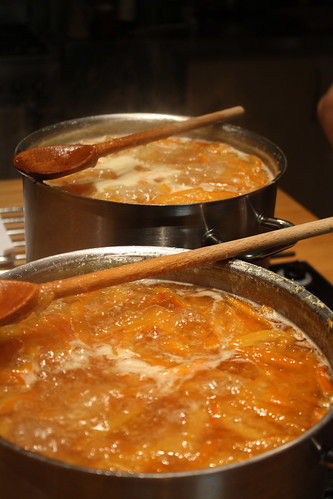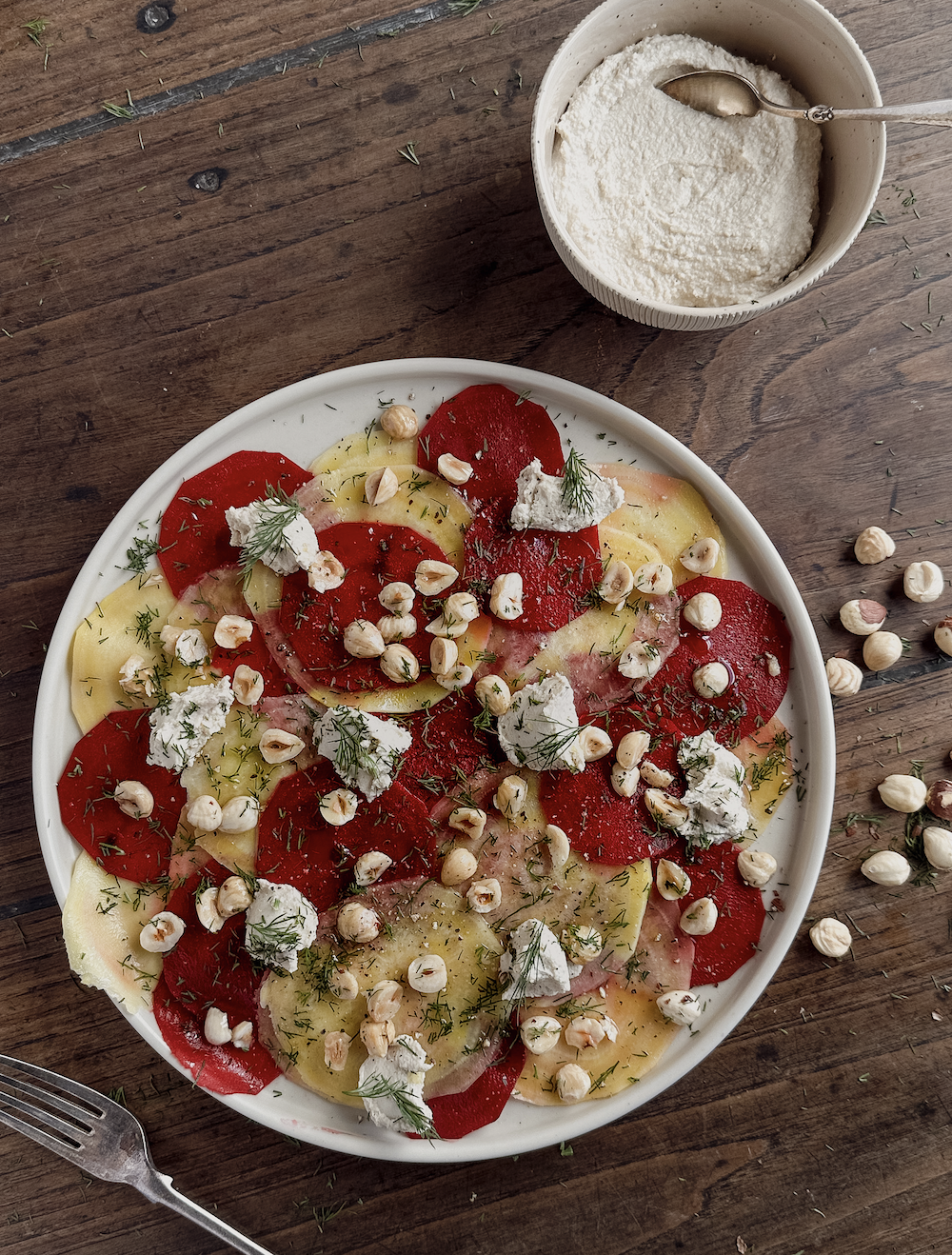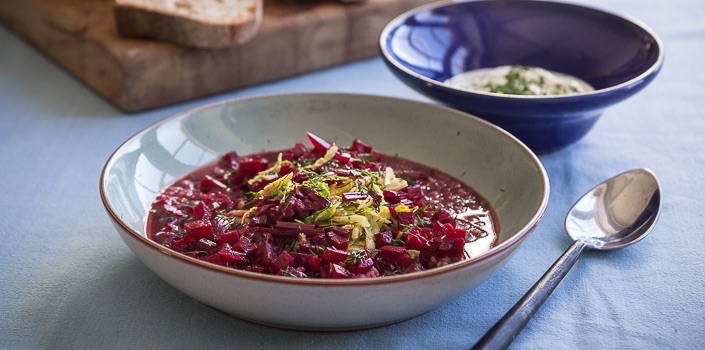Seville Orange Marmalade
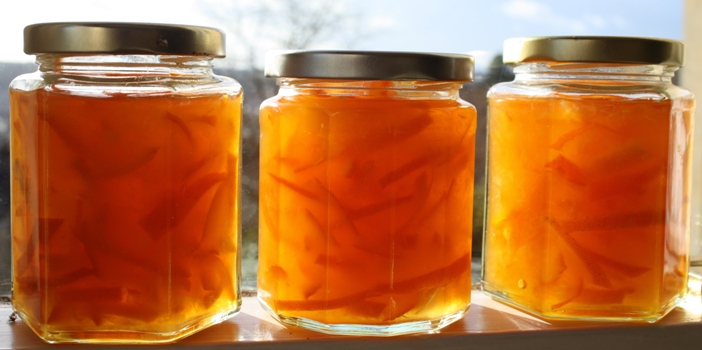
If you've never tried making your own marmalade, we encourage you to give it a go. The result will taste much better than store-bought, and you'll have the pride of mastering a new skill. It might even become a tradition. Below is our entry-level marmalade recipe from guru Christopher's recipe for Thick Cut Seville Marmalade.
Seville oranges, so called because they are grown near Seville in southern Spain, are very seasonal. They are only available for a few weeks up to the beginning of February. For quick guidance on shopping, and variations, check out Rachel's top tips on making perfect marmalade. And if you get really into it, cozy up with a cuppa and immerse yourself in Christopher's entertaining guest post on the magic - and science! - of marmalade.
Thick Cut Seville Marmalade
Ingredients:
- 1 kilo Seville oranges
- Juice of 1 lemon (use wax-free if you add the rind)
- 1 kilo granulated sugar
- 500ml water
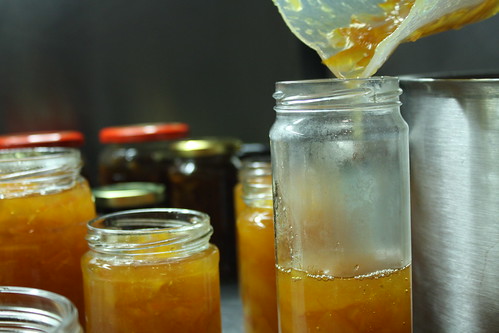
Method
1. Wash the oranges, take out the stalks, and cut them in halves around the equator.
2. Juice the oranges and the lemon, removing all the pips. Sieve the juice into a jug and retain the pips.
3 Slice the orange peel thickly (or thiner if you prefer). Place two halves of orange on top of each other, hold them firmly, and with a sharp knife slice them about ¼ cm thick. You can also slice the lemon skins if you wish. (The peel can be cut thinner if you wish, but don’t be tempted to slice it in a food processor or you are more likely to have a mushy result)
4. Put the sliced oranges and lemons into a large lidded saucepan with 300mls of the water. Cover and simmer gently for 60 minutes to soften the peel. Stir often. When ready, the pith will become more translucent and the peel will easily squash between finger and thumb. Turn off the heat.
5. While the peel is simmering, put the pips in a small saucepan with 200mls of water and simmer for 5 minutes.
6. When the peel is soft, add the juice and the sugar then stir until dissolved. Strain the pectin rich liquid the pips are simmering in, and discard the pips.
7. Put the pan back on the heat, and stirring, slowly bring to the boil. Stir often to stop the marmalade sticking and keep on a slow boil. If a scum forms, lightly scoop it off the surface.
8. Place a saucer or two in the fridge ready to test for setting point.
Also place the washed jars (but not the lids) in a medium oven (about 140C) to sterilise them and heat them so they don’t break when the hot marmalade is poured in.
9. Stir the marmalade and keep it on the heat until a rolling boil is reached (about for 30-40 minutes) and setting point will be near.
10. To test for setting point, put ½ teaspoon of the marmalade on the cold saucer in a small 50p-sized circle. Put back in the fridge for 30 seconds to cool, then take out, hold up to the light and push your finger through the jam to see if the surface wrinkles. If it does, it’s ready. If it doesn’t, try again after 1 or 2 minutes.
11. When setting point is reached, turn off the heat and leave for 10-15 mins to allow the peel to distribute evenly through the marmalade. (If you bottle it too quickly, the peel is likely to float to the top of the jars).
12. Pour the marmalade into the jars, holding the hot jar with an oven glove, using a small heat-proof jug or a pouring funnel. Immediately put on the lids, wipe off any drips when still warm. Tighten the lids. Leave the jars to cool before you label. Label before you forget to.
Tips
- For a Dark Marmalade add an extra 250g muscovado sugar. Don’t be tempted to add more than 50:50 muscavado unless you like the ‘molasses’ flavour more than you do the Seville orange.
- For added flavour add 250g chopped crystalised ginger when you take the marmalade off the heat. You can add the ginger alone or added with the muscavado is doubly delicious.
Note on setting point.
Beginners often end up with jam that either is set like heavy clay, or is as runny as before any boiling. To set into a soft gel, the jam requires acidity, sugar, and pectin and at the right temperature. Marmalade making has enough of all three ingredients and the cooking delivers the right temperature. The trick is to boil it enough to raise the temperature to 105 0C, when the sugar content is about 60-65%, but to do so quickly before both the flavour and the essential pectin are damaged. But this ‘setting’ point is not a precise setting point, and experience shows that some batches will be set but some may have to be increased another 3-50 to get a set.
It is more sensitive to use the wrinkle test than the thermometer. The setting point is just that: a ‘point’. Heat for too long at or beyond setting point and the gel will be damaged. You produce a thick mass not the lovely, light gel. The temperature changes slowly towards the 1050C and you may be watching the temperature for a long while before deciding it was at the right point. Heating for too long after setting point will damage the texture and the flavour.
There is no harm in testing for setting point too early. The marmalade on the plate will be just a patch of syrup. But you will know exactly when the setting point is reached with the first sign of wrinkling. Repeat the test once or twice more, if you are unsure, until you get a clear wrinkling that remains after your finger has pushed through the patch.
Interestingly, the gelling process continues as the jam cools in the jars and even over the first few weeks of storage. This is why it is best to stop boiling AS SOON AS you detect clear wrinkling, knowing that the jam will ease itself into an impressively delicious gel. Boil for too long after setting point and the result is a heavy, stiff set.
Making excellent marmalade is an art. The art is in the setting point as much as in the flavours. Simple experience will polish your art and maximize your satisfaction.
Recipe from Christopher Robbins.
